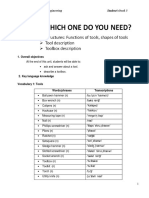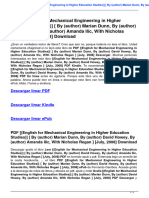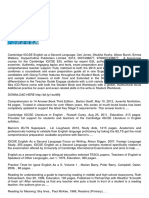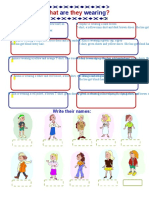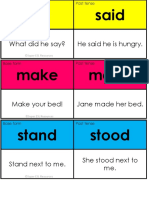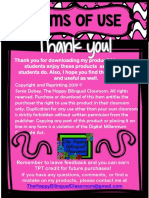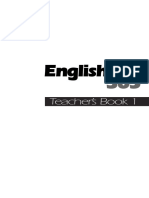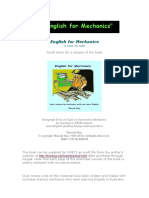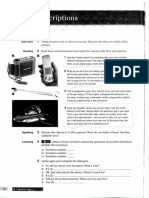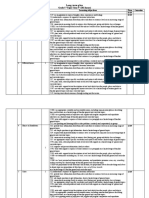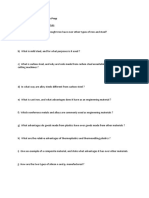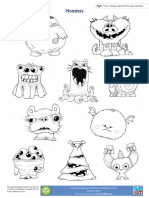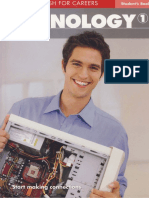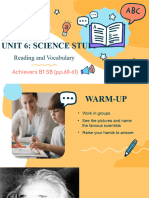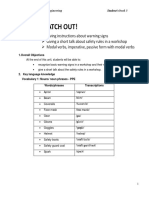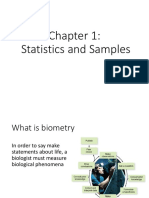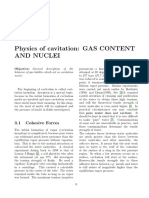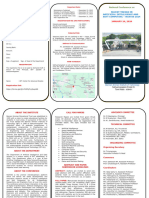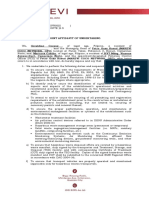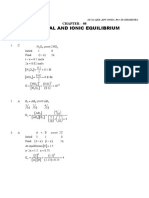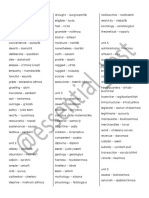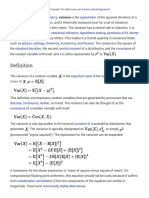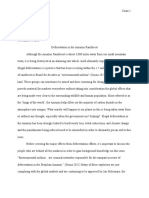English for Mechanical Engineering Student’s book 3
1. Overall objectives
At the end of this unit, students will be able to:
ask and answer about measurements of items and properties of materials.
describe features of objects: materials, properties, measurements.
2. Key language knowledge
Vocabulary
Words/Phrases Transcriptions
Alloy (n) /ˈælɔɪ/
Aluminum (n) /ˌæljəˈmɪniəm/
Brittle (n) /ˈbrɪtl/
Ceramics (n) /səˈræmɪkz/
Conductor (n) /kənˈdʌktə/
Copper (n) /ˈkɒpə(r)/
Corrosion-resistant (adj.) /kəˈrəʊʒ(ə)n rɪˈzɪstənt/
Elastic (adj.) /i'læstik/
Ferrous (adj.) /ˈferəs/
Flexible (adj.) /ˈfleksəbl/
Glass (n) /ɡlɑːs/
Hard (adj.) /hɑːd/
Heat-resistant (adj.) /ˈhiːt rɪˈzɪstənt /
Heavy (adj.) /ˈhevi/
Insulator (n) /ˈɪnsjʊleɪtə/
1
�English for Mechanical Engineering Student’s book 3
Iron (n) /ˈaɪən/
Light (adj.) /laɪt/
Malleable (adj.) /ˈmæliəbl/
Material (n) /məˈtɪəriəl/
Metal (n) /ˈmetl/
Natural (adj.) /'næt∫rəl/
Non-ferrous (adj.) /nɒnˈferəs /
Non-metal (n) / nɒn ˈmetl/
Plastic (n) /ˈplæstɪk/
Property (n) /ˈprɒpəti/
Rubber (n) /ˈrʌbə(r)/
Soft (adj.) /sɔft/
Stainless steel (nphr.) /ˌsteɪnləs ˈstiːl/
Steel (n) /stiːl/
Strong (adj.) /strɒŋ/
Synthetic (adj.) /sin'θetik/
Weak (adj.) /wiːk/
Wood (n) /wʊd/
Centimeter/ Centimetre = cm (n) /ˈsentɪmiːtə(r)/
Foot -feet (số nhiều của foot) (n) /fʊt/ - /fiːt/
Inch (n) /ɪn(t)ʃ/
Meter/metre = m (n) /ˈmiːtə(r)/
Millimeter/ Millimetre = mm (n) /ˈmɪlimiːtə(r)/
2
�English for Mechanical Engineering Student’s book 3
Grammar 1: Simple Present Passive
Active Passive
In the active voice the subject of In the passive voice the subject of the
the sentence DOES the action. sentence RECEIVES the action.
To change an active voice sentence into a passive voice sentence:
Change the object of the active sentence into the subject of the passive sentence.
Use the verb “be” in the same tense as the main verb of the active sentence.
Use the past participle of the main verb of the active sentence.
Grammar 2: Structures to ask and answer about materials and properties.
Structures to ask and answer about materials
Forms Examples
What + [be] + S + made of? What is this screwdriver made of?
S + [be] + made of /from+ material. It’s made of steel and plastic.
3
�English for Mechanical Engineering Student’s book 3
Note:
“be made of” is used when we can see the material in the product.
E.g. Tyres are made of rubber.
“be made from” is used when we can’t see the material in the product.
E.g. Paper is made from wood.
Structures to ask and answer about properties.
Forms Examples
What + [be] + the property of + S? What is the property of glass?
S + [be] + adj.
S + [be] + (a/an) adj. + N. It is brittle. / It is a brittle material.
Grammar 3: Structures to ask and answer about measurements.
Some commonly- used nouns and adjectives.
Adjectives Nouns
- Long - Length
- Wide - Width
- High - Height
- Deep - Depth
- Thick - Thickness
Structure to ask and answer about measurements.
Forms Examples
Questions
- What + [be] +the + N+ of + S? - What is the length of the bolt?
- How + adj. + [be] +S? - How long is the bolt?
Answers
- S + [be] + ………..adj. - It is 2 cm long.
- S + [be] + ………in + N. - It is 2 cm in length.
- The + N + of…. is……. - The length of the table is 40 cm.
4
�English for Mechanical Engineering Student’s book 3
Lesson Objective: After the lesson, students will be able to ask and answer about measurements
of items and properties of materials.
Warm up:
Work in groups.
Watch a video and write down words about materials and properties.
Materials Properties
Activity 1A: Magic wheel
Work in groups
Each group takes turns to spin the wheel.
Use the suggested information to complete sentences with ONE word.
5
�English for Mechanical Engineering Student’s book 3
Activity 2A: What’s it made of?
Work in pairs.
Student A looks at pictures on this page.
Student B looks at pictures on page 108.
Ask and answer about things as sample.
Sample:
A: What is it? / What is it called? A: What are they? / What are they
B: It is a work bench. / It is called a work called?
bench. B: They are bottles. / They are called
A: What is it made of? bottles.
B: It is made of wood. A: What are they made of?
A: What is the property of it? /What’s its B: They are made of glass.
property? A: What is the property of it? /What’s its
B: It is strong and durable. property?
B: It is brittle.
6
�English for Mechanical Engineering Student’s book 3
Student A
Picture 1 Picture 2 Picture 3
Picture 4 Picture 5 Picture 6
Picture 7 Picture 8 Picture 9
Activity 3A: Describing pictures
Work in groups.
Look at the pictures.
Take turns to make as many sentences as possible to describe each picture (name of thing,
material, property of material, color, quantity, origin, function.)
Sample:
Picture 1: They are (called) nuts. There are 2 nuts. They are made of steel. It’s strong and
corrosion-resistant. ….
7
�English for Mechanical Engineering Student’s book 3
Activity 4A : Role-play
Work in pairs
Play roles of a shop assistant (SA) and a client (C) to make a conversation in a PPE shop
and a hard ware store based on the information in the following cards.
Sample:
SA: Good morning. Can I help you?
C: I’d like to buy……..
CARD 1:
Shop assistant Customer
Greeting
Say you want a pair of goggles
Ask what kind needed
Ask for recommendation
Say: 2 kinds available
Ask about origin
Say: 1: Japan, 2: Viet Nam
Ask about the materials
Say: 1: plastic & rubber
2: plastic & glass
Ask about the properties
Give properties: 1: light, elastic
2: light, brittle
Ask about special feature
Special feature: prevent flying particles
from damaging the eyes
Ask about the price
Say the price: 1: $10.25
2: $8.55
8
�English for Mechanical Engineering Student’s book 3
Choose one to buy
Continue to end the conversation
CARD 2:
Shop assistant Customer
Greeting
Say you want a work bench
Ask what kind needed
Ask for recommendation
Say: 2 kinds available
Ask about materials
Say: 1: wood, 2: steel
Ask about origin
Say: 1: wood – Russia
2: steel – Italy
Ask about the properties
Give properties:
1: natural, good insulator, heavy
2: corrosion-resistant, hard, strong
Ask about the price
Say the price: 1: $ 22.45
2: $25.35
Choose one to buy
Continue to end the conversation
Lesson Objective: After the lesson, students will be able to describe features of objects: materials,
properties, measurements.
Warm up:
Work in 2 groups.
Stand in 2 lines.
Listen to the words given by the teacher.
Put the words into the right category.
Materials Properties Measurement
aluminum heavy long
9
�English for Mechanical Engineering Student’s book 3
Activity 1B: Describing objects
Watch a video and pass the ball.
Describe measurements and materials of the items appearing in the video.
Use both nouns and adjectives in the answers.
Sample:
The door is 1 meter wide/ in width and 2 m high/ in height.
It’s made of wood.
Activity 2B: Objects measurement
Work in pairs.
Look at the pictures.
Ask and answer the questions about objects.
Student A uses “How”, and “adjectives” for question and answer.
Student B uses “What”, and “nouns” for question and answer.
Sample:
10
�English for Mechanical Engineering Student’s book 3
Student A Student B
A: What is it? / What is it called? A: What is it? / What is it called?
B: It’s a socket./ It’s called a socket. B: It’s a socket./ It’s called a socket.
A: How long is it? A: What is the length of it?/ What is its length?
B: It is 100mm long. B: It is 100mm in length.
A: How wide is it? A: What is the width of it?/ What is its width?
B: It is 100 mm wide. B: It is 100 mm in width.
Student A:
1………………………………………………… 2…………………………………………….
3……………………………………... 4……………………………………………
……………………………………….. ……………………………………………
11
�English for Mechanical Engineering Student’s book 3
Student B:
5………………………………………… 6…………………………………………….
………………………………………… ………………………………………………
8.……………………………………………
7……………………………………...
……………………………………………
………………………………………..
Activity 3B: Exchanging information
Work in pairs.
Ask and answer to complete the information about the oil tank.
Student A looks at the picture on this page.
Student B looks at resource files (Unit 3- Activity 2B)
Student A’s picture
12
�English for Mechanical Engineering Student’s book 3
OIL TANK
1 Number 1: tank Steel malleable
2 Number 2: cover Plastic light
3 Height (tank) 65cm
4 Number 3: .…………… ……………… ………………..
5 Number 4: …………… ………………… ………………..
6 Length (cover) ………………………………………..
7 Width (cover) …………………………………………..
Activity 4B: Describing things
Work individually.
Look at the picture.
Complete the label using your imagination.
Make a description based on the following suggested questions:
1. What is it called?
2. What is it used for?
3. How many pipes does it have? What are the pipes made of?
4. What is the cover made of? What is the property of this material?
5. What is the height, width and length of the tank?
13
�English for Mechanical Engineering Student’s book 3
It is called a tank; it is for putting oil or liquid. This tank has 2 pipes and a cover………….
……………………………………………………………………………………………………….
……………………………………………………………………………………………………….
……………………………………………………………………………………………………….
……………………………………………………………………………………………………….
……………………………………………………………………………………………………….
5. Students’ self-assessment
Look at the objectives specified at the beginning of the unit and write down what you have (not)
achieved and what you need to do to improve your English.
14
